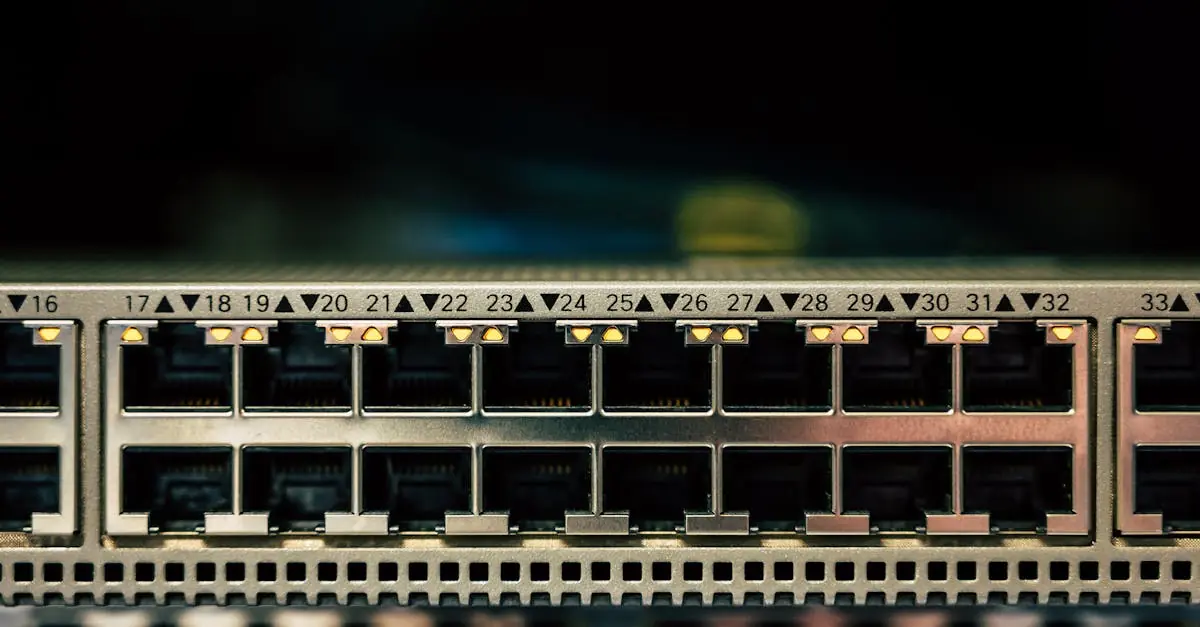In today’s tech-savvy world, powering up devices while keeping the clutter at bay is the dream. Enter the PoE switch—a true superhero in the realm of networking. With the power to deliver both data and electricity through a single cable, it’s like having your cake and eating it too, minus the crumbs.
Table of Contents
ToggleOverview of PoE Switch
Power over Ethernet (PoE) switches simplify connectivity by delivering data and power through a single Ethernet cable. This technology streamlines installations and minimizes the need for multiple power sources. Common applications include IP cameras, wireless access points, and VoIP phones.
Versatile in design, PoE switches can support various power outputs. Most models supply 15.4 watts, while others increase capacity to 30 watts or more per port, addressing the needs of power-hungry devices. The implementation of IEEE standards, specifically 802.3af and 802.3at, ensures compatibility and efficiency in power delivery.
Networking environments benefit from PoE switches. They reduce cabling complexity and enhance scalability. Businesses often choose them for deploying devices without proximity to power outlets. By providing centralized power management, they also facilitate the monitoring of energy consumption.
Installation remains straightforward. Users connect PoE-enabled devices directly to the switch using standard Ethernet cables, which eliminates the need for additional electrical work. Moreover, many models include advanced features such as VLAN support and Quality of Service (QoS) settings, allowing for customizable network management.
Selecting the right PoE switch involves considering the total power budget and the number of devices. It’s essential to analyze power requirements and ensure compatibility with existing equipment. Overall, PoE switches represent a crucial component in modern network design, optimizing both performance and convenience.
Types of PoE Switches
PoE switches come in two main types: managed and unmanaged. Each type serves specific networking needs, offering varied features and functionalities.
Managed PoE Switches
Managed PoE switches provide advanced control over network traffic. Users configure individual ports to monitor usage and set priority levels. Security features, including VLAN support and traffic tracking, enhance overall network protection and efficiency. These switches also allow for remote management, leading to streamlined updates and troubleshooting. Organizations benefit from increased flexibility in their networking setups, accommodating future growth and changes.
Unmanaged PoE Switches
Unmanaged PoE switches offer simplicity for straightforward installations. Plugging devices directly into the switch requires no configuration, making them ideal for small networks or less complex setups. These switches provide basic power and data transmission, supporting devices without an elaborate setup. Cost-effectiveness appeals to budget-conscious individuals. Reliability in a variety of environments makes unmanaged switches a popular choice for businesses looking to grow without the overhead of advanced features.
Benefits of Using PoE Switches
PoE switches offer various advantages that enhance networking capabilities. Users benefit from both financial savings and reduced complexity in their installations.
Cost-Effectiveness
Cost savings emerge from using PoE switches in several ways. Organizations avoid purchasing separate power supplies and electrical infrastructure for devices. For instance, powering an IP camera or a VoIP phone directly through the Ethernet cable minimizes installation costs. Additionally, many PoE switches support power budgets that cater to multiple devices simultaneously, providing flexibility and scalability. It’s essential to consider that reduced cabling and labor expenses contribute to overall budget efficiency. Enhanced monitoring features found in managed PoE switches also enable users to optimize power usage, resulting in lower electricity bills.
Simplified Installation
Simplified installation processes stand out as one of the main advantages of PoE switches. Users can connect devices directly to switches with standard Ethernet cables, eliminating the need for additional electrical work. This plug-and-play capability significantly reduces installation time and labor costs. They can quickly deploy devices, such as wireless access points, in locations without nearby power outlets. Many PoE switches are designed with user-friendly interfaces, making setup and management effortless. Simplification also fosters a more organized network environment by reducing cable clutter and ensuring efficient power distribution across connected devices.
Key Features to Consider
When selecting a PoE switch, specific features significantly impact performance and usability. Evaluating power budget and number of ports plays a crucial role in effective networking.
Power Budget
Power budget refers to the total wattage a switch can deliver across all ports. Most PoE switches support a minimum of 15.4 watts per port, while some devices provide up to 30 watts or more. Understanding this budget ensures adequate power for connected devices. For instance, essential devices like IP cameras and VoIP phones require specific wattage, making it vital to account for both the cumulative power requirements and the switch’s capacity. Organizations can prevent disruptions by ensuring the switch supports the total wattage needed for all devices. Tracking power utilization also aids in optimizing performance and enhancing energy efficiency.
Number of Ports
The number of ports on a PoE switch determines how many devices it can support simultaneously. Many switches come equipped with eight to 48 ports, providing options for small and large networks. Choosing an appropriate number of ports facilitates expansion as organizational needs grow. For example, a small business may find an eight-port switch sufficient for IP cameras and access points. In contrast, larger enterprises can benefit from switches with 24 or 48 ports to accommodate more devices. Evaluating the current network setup and anticipating future needs ensures the ideal switch selection for ongoing connectivity requirements.
Popular PoE Switch Brands
Several brands dominate the Power over Ethernet switch market. Cisco stands out for its robust managed PoE switches, offering advanced security features and exceptional reliability. TP-Link, known for its budget-friendly options, delivers unmanaged PoE switches that cater to small networks needing straightforward installation.
Netgear provides a wide range of choices, serving both home and enterprise environments with managed and unmanaged models. Ubiquiti’s appeal lies in its innovative designs and features tailored for more complex network setups. D-Link offers versatile PoE switches, supporting various power budgets for different devices.
MikroTik is recognized for its powerful routing capabilities combined with PoE functionality. Linksys emphasizes ease of use in its unmanaged PoE switches, making them suitable for users with minimal technical knowledge. Zyxel, with its focus on performance and energy efficiency, presents reliable options for many users.
Choosing among these brands often comes down to specific needs. Some users prioritize advanced features and configurations, while others may seek straightforward, cost-effective options. Each brand generally caters to a certain audience, ensuring there’s a suitable PoE switch available for every networking requirement.
Ultimately, selecting the right provider depends on understanding individual requirements. Users should consider factors such as the number of devices, overall power budget, and desired features before making a final decision. By evaluating these aspects in relation to brand offerings, users can find the most effective PoE switch for their setup.
Conclusion
PoE switches are transforming how organizations manage their networking needs. By combining data and power delivery into a single cable, they streamline installations and enhance efficiency. Their versatility supports a wide range of devices while simplifying network design.
Choosing the right PoE switch involves considering power budgets and port counts to meet specific requirements. With options ranging from managed to unmanaged models, users can find a solution that fits their operational needs and budget.
As technology continues to evolve, PoE switches will remain vital in creating organized and effective network environments. Investing in the right PoE switch can lead to long-term savings and improved network performance.







